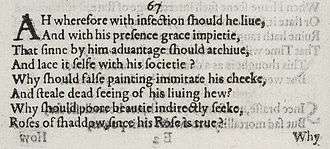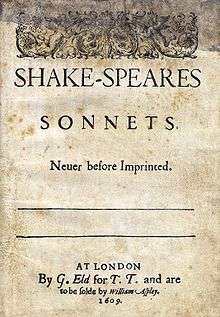Sonnet 67
| Sonnet 67 | |||||||
|---|---|---|---|---|---|---|---|
 The first two stanzas of Sonnet 67 in the 1609 Quarto | |||||||
|
| |||||||
| |||||||
Sonnet 67 is one of 154 sonnets written by the English playwright and poet William Shakespeare. It's a member of the Fair Youth sequence, in which the poet expresses his love towards a young man, and is a thematic continuation of Sonnet 66. In this poem, the speaker's anxiety about the social difference between him and his beloved takes the form of a criticism of courtly corruption. This sonnet was placed first in the pirated and mangled edition of 1640.
Structure
Sonnet 67 is an English or Shakespearean sonnet. The English sonnet has three quatrains, followed by a final rhyming couplet. It follows the typical rhyme scheme of the form, abab cdcd efef gg and is composed in iambic pentameter, a type of poetic metre based on five pairs of metrically weak/strong syllabic positions. The third line exemplifies a regular iambic pentameter:
× / × / × / × / × / That sin by him advantage should achieve (67.3)
- / = ictus, a metrically strong syllabic position. × = nonictus.
Line eight exemplifies an initial reversal, of which there are several in this sonnet:
/ × × / × / × / × / Roses of shadow, since his rose is true? (67.8)
Source and analysis
Gary Schmidgall notes that the underlying conceit of the sonnet derives from Petrarch, for whom hyperbolic praise is a main part of the stock in trade. For most critics, this theme is in this poem significant as it interacts with another theme, the corruption of the court. This theme, which was prominent in the voguish satire of the 1590s. As he would in Hamlet, Shakespeare draws on the language of abuse derived ultimately from Roman satirists such as Juvenal and Horace. The combination of satiric and romantic language is commonly said to reinforce the speaker's ambivalence about his beloved. M. M. Mahood notes the lexical uncertainty of line 1, which leaves open the possibility that the friend himself is infected. For this reason, Roger Warren points to a thematic similarity to All's Well That Ends Well, whose hero, Bertram, is similarly ambiguous.
"Lace" in line 4 has been glossed various ways. Citing Romeo and Juliet and Macbeth, George Steevens glossed it as "embellish"; Edward Dowden agreed, but George Wyndham has it as "diversify." Wyndham also perceives a reference to the "rival poet" in lines 7-8. In line 8, "seeing" is sometimes amended to "seeming" but more commonly "dead seeing" is glossed as some variation "lifeless appearance."
Notes
- ↑ Pooler, C[harles] Knox, ed. (1918). The Works of Shakespeare: Sonnets. The Arden Shakespeare [1st series]. London: Methuen & Company. OCLC 4770201.
References
- Baldwin, T. W. On the Literary Genetics of Shakspeare's Sonnets. Urbana: University of Illinois Press, 1950.
- Hubler, Edwin. The Sense of Shakespeare's Sonnets. Princeton: Princeton University Press, 1952.
- Warren, George. "Why Does It End Well? Helena, Bertram, and the Sonnets." Shakespeare Studies 22 (1969).
- First edition and facsimile
- Shakespeare, William (1609). Shake-speares Sonnets: Never Before Imprinted. London: Thomas Thorpe.
- Lee, Sidney, ed. (1905). Shakespeares Sonnets: Being a reproduction in facsimile of the first edition. Oxford: Clarendon Press. OCLC 458829162.
- Variorum editions
- Alden, Raymond Macdonald, ed. (1916). The Sonnets of Shakespeare. Boston: Houghton Mifflin Company. OCLC 234756.
- Rollins, Hyder Edward, ed. (1944). A New Variorum Edition of Shakespeare: The Sonnets [2 Volumes]. Philadelphia: J. B. Lippincott & Co. OCLC 6028485.
- Modern critical editions
- Atkins, Carl D., ed. (2007). Shakespeare's Sonnets: With Three Hundred Years of Commentary. Madison: Fairleigh Dickinson University Press. ISBN 978-0-8386-4163-7. OCLC 86090499.
- Booth, Stephen, ed. (2000) [1st ed. 1977]. Shakespeare's Sonnets (Rev. ed.). New Haven: Yale Nota Bene. ISBN 0-300-01959-9. OCLC 2968040.
- Burrow, Colin, ed. (2002). The Complete Sonnets and Poems. The Oxford Shakespeare. Oxford: Oxford University Press. ISBN 978-0192819338. OCLC 48532938.
- Duncan-Jones, Katherine, ed. (2010) [1st ed. 1997]. Shakespeare's Sonnets. The Arden Shakespeare, Third Series (Rev. ed.). London: Bloomsbury. ISBN 978-1-4080-1797-5. OCLC 755065951.
- Evans, G. Blakemore, ed. (1996). The Sonnets. The New Cambridge Shakespeare. Cambridge: Cambridge University Press. ISBN 978-0521294034. OCLC 32272082.
- Kerrigan, John, ed. (1995) [1st ed. 1986]. The Sonnets ; and, A Lover's Complaint. New Penguin Shakespeare (Rev. ed.). Penguin Books. ISBN 0-14-070732-8. OCLC 15018446.
- Mowat, Barbara A.; Werstine, Paul, eds. (2006). Shakespeare's Sonnets & Poems. Folger Shakespeare Library. New York: Washington Square Press. ISBN 978-0743273282. OCLC 64594469.
- Orgel, Stephen, ed. (2001). The Sonnets. The Pelican Shakespeare (Rev. ed.). New York: Penguin Books. ISBN 978-0140714531. OCLC 46683809.
- Vendler, Helen, ed. (1997). The Art of Shakespeare's Sonnets. Cambridge, MA: The Belknap Press of Harvard University Press. ISBN 0-674-63712-7. OCLC 36806589.
.png)
